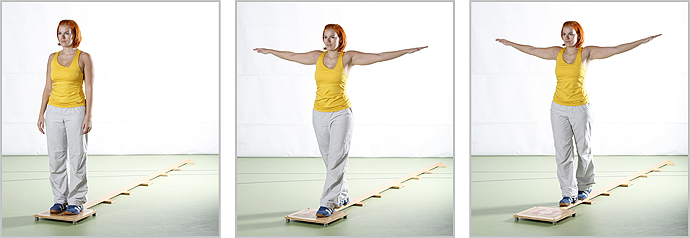Balancing Backw (BalBw)
Back to overview
1. Test objective
Determination of coordination performance in precision tasks.
2. Description of the task

Backward balancing involves balancing backward over the individual bars of different widths in 2 valid attempts each.
This is done in the following order: 6 cm wide bar, 4.5 cm wide bar and 3 cm wide bar. The test attempt always starts from a starting board. Before the two test attempts per beam, one trial attempt is performed forward and one backward over the entire length of the bar. If the test person leaves the bar during the trial, balancing is continued at the same point. Each beam is thus balanced 1x forward and 1x backward as a preliminary exercise, and then 2x backward for performance measurement. In total, 6 valid attempts are scored. The test leader demonstrates the test task before the test begins. The number of steps is counted. The first foot touching down is not yet counted. Only when the second foot leaves the starting board and touches the bar, the steps (points) are counted. A maximum of 8 points can be achieved per attempt. The speed can be chosen by the test person (there is no time limit).
3. Test materials
| 3.1 | Space requirements: 4 m x 3 m |
| 3.2 | Time and person requirements: 1 test leader can test 1 test person within 6 minutes |
| 3.3 | Equipment and materials: tape, balance bars in bar widths of 3 cm, 4.5 cm and 6 cm with a bar height of 5 cm each and a bar length of 300 cm each. Starting board: Length = 40 cm, width = 40 cm, height = 5 cm. |
4. Test setup
The 3 bars and the start board are attached to the floor in a non-slip manner with adhesive tape. The start board is always placed at the current test beam for the test participant. There should be no objects in the immediate area of the bars.
5. Measurement recording
The number of times the foot touches down while walking backwards over the bar is counted. The first foot touchdown is not yet counted. Only when the second foot leaves the starting board and touches the bar, the test leader counts the points (steps) aloud. The number of steps is scored until one foot touches the floor or 8 points are reached. If the distance is covered with less than 8 steps, 8 points are to be credited. The sum of the steps from the total of 6 runs is entered on the evaluation sheet (max. 48 steps).
Standard values
Gender- and age-specific norms (N = 1472) are available from both 1974 (KTK) and 2009 (DMT).
6. Test instruction
In this test you have to balance backwards on the bar. You must not step next to the bar while doing this. Let's practice balancing first. You walk forward over this bar until you reach this board. There you stand for a moment with both feet next to each other. Then you carefully walk backwards, not stepping next to the bar. After we have practiced this, you stand on the board again and then walk backwards. I count how many steps you manage. I only start counting when both feet have left the starting board. When one foot touches the floor next to the bar, the attempt is over. You then go right back to the board and start again.
7. Special notes
The exercise is performed with sports shoes.
The bars should be placed sufficiently far away from the wall or other objects so that the test person cannot support himself and there is no risk of injury.
Sources of error
The test person does not want to perform the trial tests or aborts them prematurely. This is bad for the standardization of the test task and should be prevented.
The test person taps or steps again with one foot on the initial board for stabilization in case of initial difficulties.
8. Sources
Bös, K., Schlenker, L., Büsch, D., Lämmle, L., Müller, H., Oberger, J., Seidel, I. & Tittlbach, S. (2009). Deutscher Motorik-Test 6-18 (dmt 6-18). Hamburg: Czwalina.
Kiphard, E. J. & Schilling, F. (2007). Körperkoordinationstest für Kinder (KTK) (Testmanual von F. Schilling). Göttingen: Hogrefe.
Schilling, F. (1974). Körperkoordinationstest für Kinder KTK. Testmanual. Weinheim: Beltz-Verlag.
